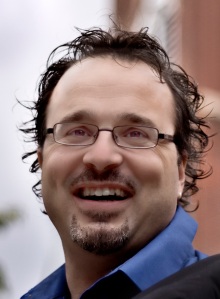On Saturday, I drove four hours to the York Emporium bookstore in York, Pa., to attend a memorial observance for the horror writer J.F. Gonzalez, who recently died of cancer at the age of 50.
Some of his notable works include “Clickers,” “Fetish,” “Bully” and “Survivor.” About 40 people attended, including some prominent writers and editors whom I’d rather not name. Not that there was anything shameful or secretive about the gathering. Quite the opposite. Despite the occasion’s underlying sadness, it was very convivial and heart-warming. It’s just that the vibe was more about private paying of respects than public spectacle. And I don’t want to turn this post into an exercise in name-dropping that will take the focus away from Gonzalez — or Jesus, his real first name.
Gonzalez specialized in a singularly disturbing variety of horror. For a long time, he sported a daunting personal appearance that seemed consistent with the type of man who would write material like that — with long hair and a leather jacket.
Yet speaker after speaker on Saturday gave similar accounts of a first face-to-face encounter with Gonzalez. Of being unnerved at the prospect of meeting a man who looked and wrote like that, only to be surprised and eventually charmed by what a truly nice guy he was.
I met Gonzalez only once, and my experience was the opposite of that described by many of the other guests. By the time I met him at a book event, he’d ditched the leather-and-long-hair look. I’d yet to read any of his books. I spoke to him for a while and found him to be a very friendly, gracious and engaging person. I bought his book “Survivor,” in part because other readers whose tastes I respect were fans of his, and in part because I liked him instantly.
I took it home and read it. And … holy shit. “Horrific” barely covers it. The book was unrelenting in its utter brutality and hopelessness. Its depiction of the human capacity for evil at its most vile and depraved.
I tried to reconcile the contents of the book with the witty, affable man who signed it for me when I purchased it. I thought: “Goddamn. He’s a nice guy, but he’s got a real dark side to him.”
But you know who else has a dark side? Me. And you. And every other human being who’s ever walked the face of this earth.
The people who deny that do the real damage. They’re the ones who fear that part of themselves to a point where they try to shut it out. They’ll attempt to achieve this by denying that they harbor a dark side, and condemning anyone who does (ie: everybody) as fundamentally baneful, debased and sick.
Worse, those dark-side-deniers are vampiric. Listen to them, and they’ll convince you that you’re the only one with a dark side, and you should hate yourself because of it. That you must keep it hidden, lest anyone suspect. That the best way of accomplishing this is to lash out and accuse others. To become a dark-side-denier yourself.
Writers like Gonzalez? They simply acknowledge that dark side. They explore its parameters so that you can recognize it in yourself, and make a conscious decision not to give into it.Although you may occasionally want to dip a toe into it and savor the frisson, maybe through bracing works such as “Survivor” and “Clickers.”
In martial arts training, I’ve found that the toughest guys tend to be the nicest. Secure in their toughness, they aren’t plagued by the insecurity that forms the underpinning of so much asshole behavior. And I figure that’s why Gonzalez was so nice in person. He made peace with his dark side, and it held no power over him.
That was his talent. His artistry. Just wish he got to practice it a while longer.


